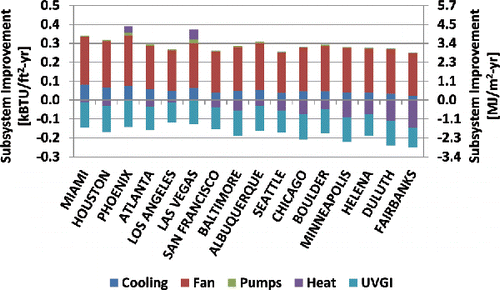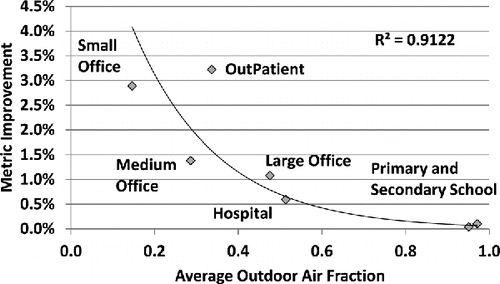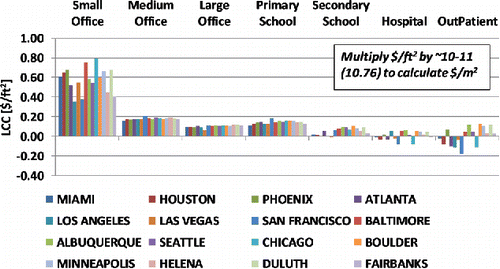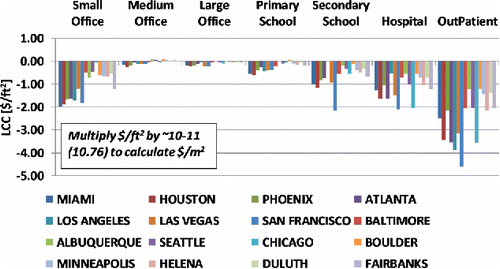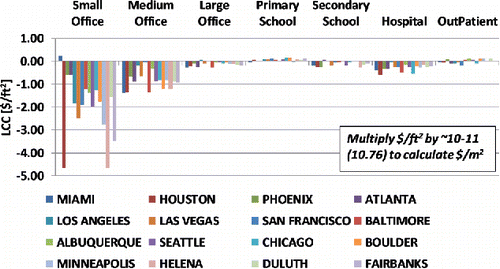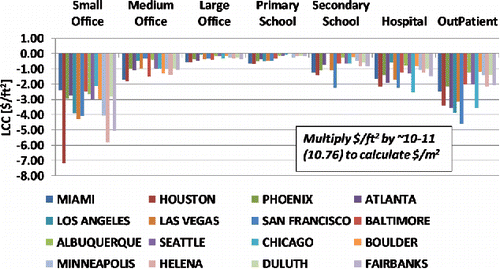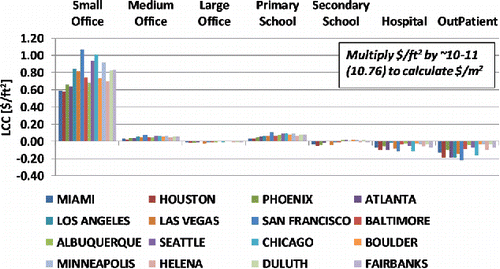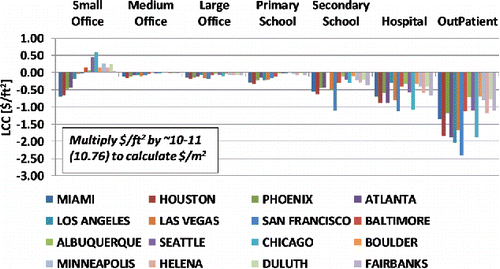Abstract
Ultraviolet germicidal irradiation of cooling coil airside surfaces is used to mitigate biofouling caused by viable microorganisms captured from the air. However, few peer-reviewed studies have investigated its effectiveness. Part 1 of this study presents the results of field measurements of changes in coil performance after treatment with ultraviolet germicidal irradiation. Part 2 reports modeled energy use and indoor air quality impacts of coil irradiation, as well as results of a life-cycle cost analysis that combines energy, indoor air quality, capital, and maintenance costs. Life-cycle costs with coil ultraviolet germicidal irradiation are compared to life-cycle costs with mechanical coil cleaning. Models from the U.S. Department of Energy Commercial Reference Buildings set were used to predict the benefit of ultraviolet germicidal irradiation treatment of fouled coils for 7 buildings in 16 climate zones using pressure drop reduction estimates bounded by experimental results from Part 1 and results reported in literature. Indoor air quality benefits were estimated using a stochastic implementation of the Wells-Riley equation to predict infection rates and monetized metrics appropriate to the various occupancies considered. Using lower estimates of ultraviolet germicidal irradiation energy use impact, ultraviolet germicidal irradiation was economically superior to mechanical cleaning only when collateral air treatment benefits were considered. At the higher level of estimated improvement, ultraviolet germicidal irradiation was superior even without consideration of air quality impact.
Introduction
Biological growth on cooling coils, biofouling, obstructs airflow and acts as insulation on heat transfer surfaces. It can affect HVAC system performance by increasing energy use of fans, pumps, and refrigeration equipment and, in severe cases, may cause cooling capacity shortfall. Ultraviolet germicidal irradiation (UVGI) is one way of mitigating biofouling and maintaining proper system operation. UVGI inactivates microorganisms, preventing further growth.
This article is Part 2 of a two-part summary of ASHRAE RP-1738 (Bahnfleth and Firrantello Citation2017). Part 1 (Firrantello et al. Citation2017) summarizes results of field measurements of pressure drop and heat transfer data from two cooling coils treated with UVGI. This article uses results of those measurements and other published data in a parametric modeling study of energy, indoor air quality (IAQ), and economic benefits of UVGI for coil cleaning for a set of building models representative of a portion of the U.S. building stock in a variety of climates.
Background
UVGI disinfection
Low-pressure mercury vapor lamps produce UV light at 254 nm, which can be used to inactivate microorganisms in water, air, and on surfaces by damaging their DNA. UVGI disinfection, to a first approximation, follows an exponential dose-response relationship (ASHRAE Citation2016):
(1) where S is the surviving fraction of an initial population N0, Nt is the population after time t [s], k [cm2/μW-s] is a microorganism-specific rate constant, and I [μW/cm2] is the average irradiance. Aspects of UVGI theory, technology, and application are reviewed extensively by ASHRAE (Citation2015b, Citation2016) and Kowalski (Citation2003, Citation2009).
IAQ modeling
Modeling airborne infection rates
A frequently used basis for assessing epidemiological benefits of air quality interventions that reduce risk of infection is the Wells-Riley equation (Nardell and Keegan Citation1991; Wells Citation1943):
(2) where Nc is the number of new cases in a population, S is the number of susceptibles, I is the number of infectors, q is the quanta of disease produced per unit time per infector, p is the pulmonary ventilation rate of a susceptible individual, t is time during which susceptibles are exposed to infectors, and Q is ventilation rate. The Wells-Riley equation was developed to relate new cases of airborne infection over time to ventilation rate, but it can represent the effect of other interventions such as air cleaners for which performance can be expressed as an equivalent ventilation rate.
Equation Equation2(2) is the original, deterministic form. A stochastic implementation (Noakes and Sleigh Citation2009; Noakes et al. Citation2012; Renshaw Citation1995) is:
(3) where tne is time to the next infection and W is a uniform random variable. This implementation treats infections as events that happen one at a time (i.e., Poisson processes). A limitation of both Equations Equation2
(2) and Equation3
(3) is that they cannot model time variation of populations or ventilation rates in a straightforward way. To rectify this, the following stochastic adaptation of the deterministic form was developed:
(4) where Pinf is the probability of an infection event in a time increment Δt = ti-ti-1. It has been demonstrated to produce output similar to Equation Equation3
(3) . Equation Equation4
(4) is valid for a suitably small increment of t, for which Pinf << 1. If the time interval is too large (and Pinf approaches 1), the assumption of a Poisson process is not valid, and the choice of Δt influences the results. For example, if modeling disease spread through an office for an 8-hour workday, a Δt of 1 minute and a Δt of 2 minutes would produce almost identical results and “smooth” curves. However, a Δt of 4 hours would produce much different results.
In the general case where multiple removal mechanisms act on air in a system, for example, ventilation and air cleaners, the combined effect of these mechanisms can be represented in terms of an equivalent outdoor airflow. For ventilation, particulate filtration, and UVGI in series, the equivalent ventilation rate can be expressed as a fraction feq of supply air as follows:
(5) where fOA is the actual outdoor air fraction, ηf is the single pass filtration efficiency, and ηUVGI is the single pass inactivation rate of the UVGI system.
Quantifying effects of infections
Two approaches to quantifying health effects are discussed. The first is direct quantification of the cost of illness. The second is diminished quality of life, commonly expressed in Disability Adjusted Life Years (DALYs).
Direct quantification of the cost of illness is possible when worker absences (Work Loss Days [WLDs]) and hospital-acquired infections (HAIs) can be calculated. For example, Fisk et al. (Citation2005) evaluated the monetized energy and health benefits of air economizer controls in office space. They expressed health benefits in terms of decreased risk of infection via the Wells-Riley equation, which they used to estimate reduction in baseline WLDs. The economic benefit of reduced WLDs was estimated using typical salary data (e.g., per capita gross national income [GNI]). As shown in , typical WLDs/person-year varies with source and classification. A similar approach can be used to calculate economic value of reductions in HAIs. Details of HAI incidence rate and determination of monetary value of WLDs and HAIs, are discussed in the Methodology section.
Table 1. Baseline rates of work absence.
The World Health Organization (WHO Citation2015) states that a DALY “can be thought of as one lost year of ‘healthy’ life:”
(6) where YLL is years of life lost due to premature death, and YLD is equivalent years lost to disability (including temporary sickness and injury). The inclusion of YLL is possible only for contaminants with quantified health effects such as ozone and PM2.5 (see, for example, Aldred et al. [Citation2015]; Cohen et al. [Citation2005]). The objective of this analysis is to assess the impact of normally nonfatal illnesses, like seasonal colds, for which the primary consequence is absence from work, school, etc. Therefore, YLL is set to zero, and Equation Equation6
(6) becomes:
(7) where Ic is the incidence rate [1/year], DW is the disability weight (the severity of a given disability on a scale from 0–1 with 0 indicating perfect health and 1 indicating death), and L is the average duration [years] of a case until ended by death or remission. Values for Ic and DW are tabulated for a wide range of diseases and injuries (Mathers et al. Citation2006). Values of DW were originally developed by surveys of professionals (Hofstetter Citation1998). The monetary value of a DALY is not well-defined (Edwards Citation2011). It varies by country with purchasing power, and has been estimated at 0.4 to 5 times the per capita GNI of the country of interest. The choice, application, positives, and negatives of DALYs and similar measures are bodies of work unto themselves, and will not be discussed in detail here.
Methodology
Energy modeling
Whole building energy simulation with U.S. Department of Energy (DOE) EnergyPlus v 8.2 software (DOE Citation2012) was used to assess the nature and magnitude of effects from UVGI coil treatment for a range of building types and climates. Of particular value to this research are (Equation1(1) ) the ability EnergyPlus offers to model different methods of fan operation; and (Equation2
(2) ) the availability of a relatively new coil fouling module that allows explicit entry of coil heat transfer coefficient values for the simple chilled water coil model in the software.
To bound energy savings, two sets of pre-UVGI/post-UVGI models were run. The first established a lower bound using pressure drop and heat transfer coefficient results from coil cleaning UVGI applied to a visibly fouled coil in an air-handling unit (AHU) serving a classroom/laboratory building in Tampa, FL (Firrantello et al. Citation2017). At this site, data on air and water state points, air and water flow rates, and airside pressure drop were collected at one-minute intervals in order to characterize coil operation pre- and post-UVGI. The second used the larger pressure drop improvement reported by Keikavousi (Citation2004) together with Tampa heat transfer coefficient results because Keikavousi did not report heat transfer data. summarizes these two scenarios and their designation in the text. The same adjustments for post-UVGI operation were made in all climates. Although it is quite possible that there are regional differences in fouling rate and severity, the data needed to specify regional variation was not available.
Table 2. Considered levels of ΔP effect due to fouling.
Reference buildings and climates
To represent a range of possible applications, seven building models were selected from the 16 DOE Commercial Reference Buildings set (Deru et al. Citation2011). summarizes selected building types and their characteristics. All buildings comply with ASHRAE Standard 90.1-2004 (ASHRAE Citation2004).
Table 3. Characteristics of selected DOE commercial reference buildings.
The United States is broken up into 16 climate regions based on heating-degree days and cooling-degree days, and further divided into sub-regions based on humidity (ASHRAE Citation2004). A representative city from each primary region was used in the simulations to determine the range of climate effects, resulting in a total of 224 simulations: 7 buildings, 16 climates, and pre-/post-UVGI coil condition.
Modeling fan power changes
Design fan power in EnergyPlus is specified by a combination of user inputs (design pressure drop, fan efficiency) and software-calculated inputs (design airflow rate). The difference between pre- and post-UVGI fan power is expressed by changing the design pressure drop while keeping all other inputs identical, resulting in a linear relationship between ΔP and power increase. Post-UVGI models used the design pressure drop included in the Commercial Reference Building files. Pre-UVGI models were assumed to have that design pressure drop plus the upper or lower bound percentage pressure change in . This increase is based on a design cooling coil pressure drop of 0.75 in. wg (187 Pa).
The interaction between turbomachinery (fans, pumps) and attached systems can be complex. In the previous situation, the quadratic relationship between ΔP and power indicated by the fan affinity laws does not apply due to changes on both the fan and system sides. While whole-building energy simulation programs do not explicitly model these interactions (e.g., selected fan curves, motor curves, system curves), the approximations in the software have been developed to aid evaluation of system types without the need for a full duct layout and fan selection.
Modeling coil heat transfer and pump energy use changes
The EnergyPlus hydronic heating and cooling coil fouling module allows direct specification of the nominal heat transfer coefficient (UA) value of coils at reference conditions of 26.67°C (80°F) inlet air dry-bulb temperature, 19.44°C (67°F) inlet air wet-bulb temperature, and 6.67°C (44°F) inlet chilled water temperature (DOE Citation2014). The calculation of the actual and nominal UA values was described in Part 1 (Firrantello et al. Citation2017) and by Wang et al. (Citation2016, Citation2017). Analysis of Tampa site data found a 14.7% reduction in nominal UA due to fouling. This was applied to the design UA of the two DOE Commercial Reference building models that could use the EnergyPlus coil fouling module: The Large Office and the Secondary School. Reduction in heat transfer performance was not considered for the other buildings because information on fouling effects on direct expansion (DX) cooling coils was not collected.
For a given load met by a chilled water system, the reduction in heat transfer coefficient results in a lower waterside temperature difference, thereby increasing the water flow rate needed to meet the load. The increase in waterside flow rate results in an increase in pump energy use throughout the year.
Monetized airborne infection effects modeling
The modeling of IAQ impacts of coil irradiation was a 3-step process:
| 1. | Calculate baseline value of the appropriate metric (WLD, HAI, or DALY per year) and its monetary value. | ||||
| 2. | Back-calculate the daily probability of infector presence in the building that generates the baseline value of each metric using the stochastic Wells-Riley model (Equation Equation4 | ||||
| 3. | Calculate the new metric value based on increased equivalent ventilation due to UVGI (Equation Equation5 | ||||
Calculating baseline measures
For office building cases, IAQ impact was quantified using WLDs. The average, pre-intervention incidence rate used was 3.67 WLDs/person-year, the middle value in published by CDC (Blackwell et al. Citation2014). Assuming a 250-day working year (50, 5-day work weeks per year), the baseline value of a monetized WLD is:
(8) where MWLD is the monetary value of a WLD and GNI is the per capita gross national annual income. Given a U.S. GNI in 2015 of approximately $53,000 (World Bank Citation2013), MWLD is approximately $212.
For hospitals, monetized HAIs most appropriately reflect cost to the healthcare system. On an average day, 1 in 25 patients contracts at least one HAI (CDC Citation2014), of which 10% are by airborne transmission (Eickhoff Citation1994). From this, one can calculate the number of airborne-infection-caused HAIs in a hospital to be 1.46 airborne HAI per patient-year. The healthcare cost per HAI is estimated to be approximately $3,000 by Noakes et al. (Citation2012). No substantiation is provided for this figure, and it is low compared to other sources. Scott (Citation2009) gives HAI cost estimates of $13,000 to $17,000 per HAI, but notes the monetary value depends greatly on the type of infection. Noakes, et al.’s $3,000 valuation was chosen as a conservative estimate.
For primary and secondary schools, DALYs were used to measure IAQ impacts, as the value of a lost school day cannot be estimated unambiguously. According to Aldred et al. (Citation2015), the DALY of a lost school day is 0.0007 and the base incidence rate (illness-related absences, averaged over the United States) is 2.8 school absences/student-year (EPA Citation2008).
No clearly appropriate metric was identified for the outpatient building type. WLDs do not apply due to the transient nature of patient visits. HAIs do not apply because “… data describing risks for HAI are lacking for most outpatient settings…” (CDC Citation2015). There is no published DALY information for outpatient-acquired infections. While the results were not monetized for the noted reasons, it was nevertheless possible to calculate relative risk reduction for this occupancy.
Back-calculation of risk of infector presence
is a schematic of the epidemiological modeling process. Each simulated day begins with a stochastic determination of infector presence. If an infector is present, the day is simulated in its entirety to model the spread of infection. If an infector is not present, there are no new infections and the simulation moves to the next day. Infector presence is a binary variable assumed to be either zero or one. At the end of the yearly simulation, an average metric value/person-year based on is calculated based on building type, as previously described.
If an infector is present, the probability of infection at each time step during the day is calculated using Equation Equation4(4) . The number of infectors I is set arbitrarily to one. This makes the initial number of susceptibles S equal to the total population minus one. The rate of quanta production q is set, again somewhat arbitrarily, to 10, a value for rhinovirus (the common cold) used in Noakes et al. (Citation2012) referencing Rudnick and Milton (Citation2003). Though the k value of rhinovirus is not used for UVGI disinfection, this rate of quanta production was chosen as representative of moderately virulent diseases. By comparison, tuberculosis has a q of approximately 30. Though quanta production varies based on the specific situation, the same value was used in all simulations as, again, the focus of the analysis was on other parameters. The pulmonary ventilation rate p is roughly 6 L/min (0.36 m3/h), from an average of the median values in the EPA Exposure Factor Handbook (Citation2011) for age 21 to 71 sedentary males. Q is set to the equivalent ventilation (i.e., ventilation plus other air cleaner effects) at a given time step, calculated using feq from Equation Equation5
(5) . fOA is a transient output from the energy simulation. Filter efficiency ηf is set to 0.182, based on the approximate removal rate of a 70 nm virus using a MERV 8 filter (Kowalski and Bahnfleth Citation2002). The median diameter of viruses tabulated by Kowalski (Citation2003) is 70 nm.
The average of the pre-UVGI simulations should equal the baseline value of a given IAQ metric. The one unknown input parameter, the daily probability of infector presence (uniform distribution between 0 and 1), is adjusted until the mean metric value/person-year matches the baseline value. For example, when all small office buildings are simulated, the average WLDs/person-year should be 3.67. If a probability of 1 for all days results in less than the baseline, a multiplier is used post-calculation to generate the correct infection incidence. In reality, there would be days when more than one infector is present, increasing disease spread and the mean metric value/person-year. A model that allowed for differing probabilities of a discrete number of infectors for various percentages of building population might be more accurate, but would also be more complicated and harder to validate.
Though the daily chance of infection was adjusted so the average of the pre-UVGI simulations was the baseline of the metric of interest, sensitivity to input parameters of the stochastic Wells-Riley model was not completely eliminated. While a formal sensitivity analysis was not performed, limited testing of this method indicated that a higher quanta production rate (q) resulted in a larger standard deviation of total infected over time while maintaining the same mean.
Post-intervention equivalent ventilation rate
Calculation of ηUVGI in Equation Equation5(5) requires knowledge of the dose delivered to microorganisms in air passing through the system and their dose response. UVGI air disinfection systems were sized for each air system in each DOE Commercial Reference Building model using methods developed by Kowalski (Citation2003) that predict both surface irradiance and average enclosure irradiance. This required assumptions to be made about coil size and enclosure geometry, as the energy models do not include, nor need, information about the physical size of the equipment. Coils were sized at a 1:1.4 height to width ratio, 500 fpm (2.54 m/s) face velocity, with coil face dimensions rounded up to the next 6 in (0.15 m) increment. Enclosure depth was set to 24 in (0.61 m), and the single UV lamp spanned the width of the enclosure and was placed at a depth of 12 in (0.30 m). UV lamp power was sized to provide an average of 200 µW/cm2 at the coil face, with an allowable minimum of 50 µW/cm2, at an air speed of 500 fpm (2.54 m/s) and temperature of 55°F (12.8°C). Derating of lamp intensity due to the airspeed and temperature was calculated using Equation Equation9
(9) taken from Lau et al. (Citation2009) for a single-tube lamp in crossflow:
(9) where fDR is the power derating factor [dimensionless], Tair is the air temperature [°C], and Uair is the air velocity [m/s]. Output values are considered to be post “burn-in,” so lamp degradation over time was not modeled. UV lamps were assumed to add negligible heat and pressure drop to the airstream.
The average intensity was used to calculate the inactivation rate of a representative organism via Equation Equation1(1) . The value of k was set to 0.0002996 cm2/μJ, the median value for viruses tabulated by Kowalski (Citation2003). While k can vary widely based on type of a pathogen, a single k value is used in all simulations to evaluate the effect of other building characteristics. The median single-pass air disinfection efficiency for a system designed for surface disinfection can be around 10%, while air disinfection systems are typically designed for 85% single pass efficiency.
Economic modeling
Economic analysis combined costs for equipment, operation, and health benefits associated with differences in IAQ in a life-cycle cost analysis (LCCA) comparing the effect of coil UVGI to mechanical cleaning of the coil. The life-cycle costs (LCCs) may be considered the net costs of required maintenance. The analysis was done on a net present value (NPV) basis, with parameters adjusted to 2015 values. lists the eight scenarios considered for analysis. Note that both ΔP scenarios from were considered, as well as UVGI with and without consideration of IAQ benefit, and lower and upper bounds of mechanical cleaning cost.
Table 4. LCCA scenarios.
UVGI LCC components were installation cost, annual lamp replacement cost, annual lamp energy cost, annual system energy savings, and, when applicable, annual IAQ savings. Mechanical cleaning LCC included annual cleaning cost and annual energy savings. The annual energy savings due to mechanical cleaning were set at one-half energy savings due to UVGI, with the assumption that mechanical cleaning happens once per year and the effects of coil fouling increase linearly through the rest of the year.
The LCC may be a net cost to the owner (positive) or a net savings to the owner (negative) based on the relationship between first cost, operating costs, and operational savings. It is essential to note that the option of “taking no action” was intentionally excluded because the consequences of long-term neglect of maintenance are both costly and unacceptable. These may include greatly increased energy use, degraded IAQ, inability to meet peak loads, and shortened equipment life.
lists economic analysis parameters. provides further detail on the estimation of mechanical cleaning lower bound cost based on data from a standard reference (RS Means Citation2013).
Table 5. LCCA parameters.
Table 6. Parameters used in mechanical cleaning lower bound estimate.
Annual costs were converted to present values via the series present worth function (Fuller and Petersen Citation1995):
(10) where fAP is the factor to convert from a uniform annual series of present values to present value, d is the discount rate, and n is the number of periods (years).
Results
Energy use
Modeling predicted mean HVAC energy savings for all building types and climate zones of 0.68% with median savings of 0.47% using ΔP lower bound, and mean HVAC energy savings of 4.59% with median savings of 3.53% using ΔP upper bound. shows savings by end use subsystem. Increasing the effect fouling has on ΔP from 0.20 in. wg (37.4 Pa) to 1.17 in. wg (291 Pa) had a large impact on energy savings. Estimates based on ΔP upper bound are roughly an order of magnitude larger than those based on ΔP lower bound. In both cases the fan subsystem energy savings were largest. The percentage improvements in are relative to energy use without UVGI. Heating energy use increased with UVGI use, as the reduction of fan heat added to the airstream increases the heating requirement.
Table 7. Summary of HVAC energy savings.
shows positive mean net energy savings for all locations, including savings in cooling, fan, and pump subsystems, less additional heating energy and energy required to operate the UVGI system. On a case-by-case basis, 60% of the ΔP lower bound and 98% of the ΔP upper bound simulations showed net energy savings (not weighted for floor area or percentage of U.S. building stock).
Fig. 2. Mean modeled net energy savings using ΔP lower bound and ΔP upper bound. Net includes the savings from the cooling, fan, and pump subsystems, and the energy penalty due to the heating and UVGI subsystems.
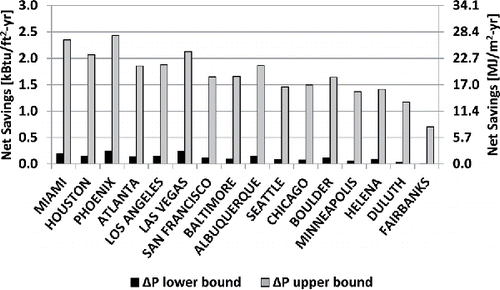
Comparison of energy savings and penalties by component in and indicate that fans were the largest contributor to mean reduced energy use in all locations, consistent with published reports of energy savings from fouling reduction (Yang et al. Citation2007a, Citation2007b). However, recent research involving detailed, custom models of chilled water system components demonstrated that chiller energy savings can approach the magnitude of fan energy savings if all coils are biofouled (Wang Citation2017).
Fig. 3. Modeled mean subsystem annual energy use savings due to UVGI for ΔP lower bound. Positive values indicate energy savings and negative values indicate energy penalty.
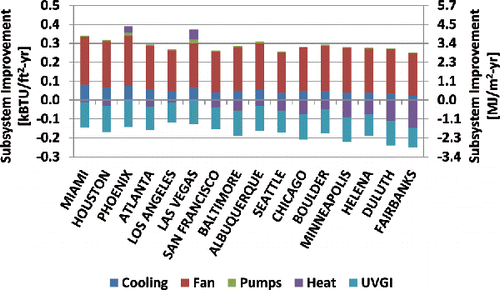
and show a small increase in heating energy to offset the fan reduction that accompanies a reduced pressure drop. However, building types with chilled water coils that used the foiling module (large office and secondary school), showed a reduction in reheat energy use. Although investigated extensively, a plausible physical explanation for this difference was not found.
IAQ effects
Results are presented via representative cross-sections by location and building type rather than both at the same time. Results for all building types are shown for Chicago (climate zone 5 A), and results for all climates zones are shown for the medium office building. Trends in these results are similar to those for other locations and building types.
As shown by , the variation across building types is strongly correlated with average OA fraction: as average OA fraction increases, metric improvement due to application of UVGI decreases. This is consistent with Equation Equation5(5) , which shows that the incremental benefit of a UVGI system of fixed efficiency will decrease as OA fraction increases, approaching zero as OA fraction approaches 100%. shows that the difference in metric improvement across climate zones for a single building type is related to variation in OA fraction, though less clearly than for multiple building types in a single location. Locations with the greatest potential to use air-side economizer controls (mild climates like those of San Francisco and Los Angeles) experienced less improvement than locations where potential was low (hot, humid climates such as Miami or Houston). Although the design outside air fraction was similar for all locations, economizer operation increases the average annual outside air fraction.
, which displays results across building types for all climates, shows that monetized benefits per unit of floor area were largest for the small office, followed by the medium office, hospital, large office, primary school, and secondary school. The differences between results for medium and large office buildings are correlated with occupant density variation. While they had similar percentages of metric improvement, the medium office has a higher occupant density (18.5 m2/occupant versus 69 m2/occupant for the large office). More occupants per unit area increased savings per unit area, and so the medium office savings were more than three times greater than those for the large office. The comparatively small benefit for the primary school and secondary school was due to the small DALY value of a school absence. The range of benefits within a building type was wide, with standard deviations at half the value of the mean or more.
Table 8. Annual economic benefit per unit area by building type (all climates).
LCCA
Eight sets of 20-year LCCs were calculated: four scenarios, each with two estimates of fouling impact (). and present mean, median, minimum, and maximum LCCs for, respectively, lower and upper ΔP bounds. Since some results showed a notable difference between mean and median (see Appendix), medians were used for comparison. For ΔP lower bound, UVGI including the IAQ benefit had the greatest value to the owner, followed by mechanical cleaning using the lower bound of cost, UVGI without IAQ benefit, and finally mechanical cleaning using the upper bound of cost. For ΔP upper bound, UVGI including the IAQ benefit had the greatest value to the owner, followed by UVGI without IAQ benefit, then mechanical cleaning using the lower bound of cost, and mechanical cleaning using the upper bound of cost. The large effect of the IAQ benefit is consistent with findings of many other investigations: productivity/absence costs are one to two orders of magnitude higher than energy costs (Fisk Citation2002). One case, the secondary school in Los Angeles, was excluded from the results because changes in energy use due to fouling caused a change in applicable rate tariff that resulted in lower energy cost with higher energy use.
Table 9. LCC using ΔP lower bound.
Table 10. LCC using ΔP upper bound.
compares the median LCC for all options for both ΔP lower bound and ΔP upper bound. tabulates the number of buildings in each scenario that resulted in a net cost savings for the owner: the choice of ΔP increase due to fouling and the inclusion of IAQ benefit both heavily influence this. As noted previously, a positive LCC (net cost) does not indicate that not cleaning the coil is preferable. Though and communicate overall trends, building type and location are discrete parameters that can significantly influence results when more granularity is needed (see Appendix).
Fig. 7. Median LCC all options using ΔP upper bound and ΔP upper bound results. A negative cost indicates a net savings to the owner.
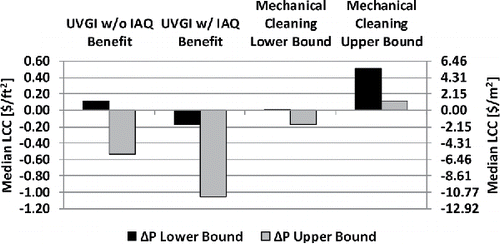
Table 11. Percentage of cases with owner net savings.
Discussion
Several factors may limit the accuracy and generality of the results. Energy modeling of the effects of biofouling was simplified in several ways. Not all standard building types were considered and, because results were not weighted by the fraction of a given type in the total building stock, overall mean and median values do not represent national averages for the United States. While all DOE climate zones were considered, assumptions about the degree of fouling were based on measurements at the Tampa, FL field test site and results from an Orlando, FL hospital reported in the literature due to the lack of climate-specific fouling data in the literature. This could overestimate the effect of biofouling in a location with a cooler, less humid climate. No model of biofouling exists that accounts for the effects of climate, operating conditions, and coil parameters. Further research on biofouling directed at development of predictive capability would be valuable. Energy savings estimates were influenced by several assumptions, in particular that the cooling coils had a clean pressure drop of 0.75 in. wg (0.187 Pa) and experience a 20%–156% increase in that pressure drop. The effect of biofouling on the COP of the DX systems was not modeled, and presents an opportunity for further experimental and simulation research.
The real discount rate and energy cost escalation rates used in the economic analysis were current estimates which historically have been subject to substantial uncertainty. The 20-year analysis period used in LCC calculations represents median coil lifetime, but longer periods giving more weight to annual costs or shorter periods more heavily weighting capital cost could be justified. Installed cost of UVGI systems and replacement cost of UVGI lamps are representative values. In particular, lamp costs vary substantially depending upon whether they are of generic or proprietary design. Mechanical cleaning cost was a best estimate involving professional judgment that could vary by an order of magnitude on a per-coil basis, and the actual frequency of cleaning could vary greatly from that assumed. The range of cost for a mechanical cleaning was over an order of magnitude. Excluding IAQ impacts, the predominant influence on UVGI economics was the degree of fouling, particularly the increase in pressure drop. Upper (from literature) and lower (from the present study) bound estimates were considered, but there remains considerable uncertainty regarding what constitutes typical fouling or how it is influenced by environmental factors, operational factors, and equipment characteristics. Finally, IAQ benefits of air disinfection, which are both large and subject to large and poorly characterized uncertainty, tend to dominate any analysis in which they are included. Given the many sources of uncharacterized uncertainty, it was not deemed feasible to conduct a formal sensitivity analysis, but these considerations should be kept in mind when interpreting modeling results.
Conclusions
A parametric modeling study of the energy, IAQ, and overall economic benefits of UVGI irradiation of cooling coils was conducted using data from a field study conducted by the authors. The primary conclusions that can be drawn from this investigation are:
| 1. | Across multiple building types and climates, energy savings from UVGI coil treatment were relatively small—no more than roughly 4.5% of HVAC energy use if the most optimistic estimates of pressure drop reduction from literature are used. Most of the energy savings were from reduced fan energy use. | ||||
| 2. | In 60% of ΔP lower bound and 98% of ΔP upper bound cases, UVGI coil irradiation resulted in net energy savings, for example, energy consumption by the UVGI system was exceeded by HVAC energy savings. These savings were highly sensitive to the level of fouling assumed. | ||||
| 3. | The estimated monetary IAQ benefit from collateral air treatment of a UVGI coil irradiation system treatment was much greater than the estimated energy cost savings. | ||||
| 4. | The largest economic benefit resulted from coil UVGI combined with collateral IAQ benefit. The smallest economic benefit resulted from mechanical cleaning at the high end of the range of assumed coil cleaning cost. When IAQ benefits were not included, whether there was a net savings from UVGI coil treatment, and the size of the savings, was highly sensitive to the degree of biofouling, particularly the increased flow resistance it causes. | ||||
Funding
The authors acknowledge with gratitude financial support for completion of this work by ASHRAE under RP-1738 and initial funding by the Consortium for Building Energy Innovation (CBEI).
References
- Adams, P.F., G.E. Hendershot, and M.A. Marano. 1999. Current Estimates from the National Health Interview Survey, 1996. Series 10, Num 200 (Vol. 10).
- Aldred, J.R., E. Darling, G. Morrison, J.A. Siegel, and R. Corsi. 2015. Benefit-cost analysis of commercially available activated carbon filters for indoor ozone removal in single-family homes. Indoor Air 26(3):510–512.
- ASHRAE. 2004. Standard 90.1 Energy Standard for Buildings Except Low-Rise Residential Buildings. Atlanta, GA: ASHRAE.
- ASHRAE. 2015a. Owning and Operating Costs. In 2015 ASHRAE Handbook: HVAC Applications. Atlanta, GA: ASHRAE.
- ASHRAE. 2015b. Ultraviolet Air and Surface Treatment. In 2015 ASHRAE Handbook: HVAC Applications (p. 60.1-60.16). Atlanta, GA: ASHRAE.
- ASHRAE. 2016. Ultraviolet Lamp Systems. In 2016 ASHRAE Handbook – HVAC Systems and Equipment (p. 17.1-17.10). Atlanta, GA: ASHRAE.
- Bahnfleth, W., and J. Firrantello. 2017. Field Measurement and Modeling of UVC Cooling Coil Irradiation for HVAC Energy Use Reduction (RP-1738). Atlanta, GA: ASHRAE.
- Barthold, R.O., and J.L. Ford. 2012. Paid Sick Leave: Prevalence, Provision, and Usage Among Full-Time Workers in Private Industry. http://www.bls.gov/opub/mlr/cwc/paid-sick-leave-prevalence-provision-and-usage-among-full-time-workers-in-private-industry.pdf.
- Blackwell, D.L., J.W. Lucas, and T.C. Clarke. 2014. Summary health statistics for U.S. Adults: national health interview survey, 2012. Washington, DC: CDC.
- BLS. 2015. CPI Detailed Report Data for December 2015.
- CDC. 2014. Data and Statistics Antimicrobial Use Prevalence Survey Estimates of Healthcare-Associated Infections Occurring in Acute Care Hospitals in the United States. www.cdc.gov/HAI/surveillance/index.html.
- CDC. 2015. Guide to Infection Prevention for Outpatient Settings: Minimum Expectations for Safe Care. Washington, DC: CDC.
- Cohen, A.J., H.R. Anderson, B.D. Ostro, K.D. Pandey, M. Krzyzanowski, N. Kunzli, K. Gutschmidt, A. Pope, I. Romieu, J.M. Samet, and K. Smith. 2005. The global burden of disease due to outdoor air pollution. Journal of Toxicology and Environmental Health, Part A: Current Issues 68(13–14):1301–7.
- Deru, M., K. Field, D. Studer, K. Benne, B. Griffith, P. Torcellini, B. Liu, M. Halverson, D. Winiarski, M. Rosenberg, M. Yazdanian, J. Huang, and D. Crawley. 2011. U.S. Department of Energy Commercial Reference Building Models of the National Building Stock. Washington, DC: US Department of Energy.
- DOE. 2012. EnergyPlus, version 8.2. Washington, DC: U.S. Department of Energy.
- DOE. 2014. Output:Table:SummaryReports. In EnergyPlus Input Output Reference. Washington, DC: DOE.
- Edwards, C. 2011. Social Cost–Benefit Analysis—Summarizing the Available Global Evidence on Drinking-Water Interventions. In J. Cameron, P. Hunter, P. Jagals, and K. Pond, eds., Valuing water, valuing livelihoods (p. 221). London: IWA Publishing.
- EIA. 2016a. Electricity Data Browser. www.eia.gov/electricity/data/browser/.
- EIA. 2016b. Natural Gas Prices. www.eia.gov/dnav/ng/ng_pri_sum_dcu_nus_a.htm.
- Eickhoff, T.C. 1994. Airborne nosocomial infection: A contemporary perspective. Infection Control and Hospital Epidemiology: The Official Journal of the Society of Hospital Epidemiologists of America 15(January):663–72.
- EPA. 2008. BENmap User's Manual Appendices. Washington, DC: EPA.
- EPA. 2011. Exposure Factors Handbook: 2011 Edition (Final Report). Washington, DC: EPA.
- Firrantello, J., W. Bahnfleth, and P.A. Kremer. 2017. Field measurement and modeling of UVC cooling coil irradiation for HVAC energy use reduction (RP-1738)—Part 1: Field measurements. Science and Technology for the Built Environment ( under review).
- Fisk, W.J. 2002. How IEQ affects health, productivity. ASHRAE Journal 44(5):56–8.
- Fisk, W.J., O. Seppänen, D. Faulkner, and J. Huang. 2005. Economic benefits of an economizer system: Energy savings and reduced sick leave. ASHRAE Transactions 111(2):673–80.
- Fuller, S.K., and S.R. Petersen. 1995. Life-Cycle Costing Manual for the Federal Energy Management Program. NIST Handbook 135. Gaithersburg, MD: NIST.
- Hofstetter, P. 1998. Perspectives in Life Cycle Impact Assessment: A Structured Approach to Combine Models of the Technosphere, Ecosphere, and Valuesphere. Dordrecht, The Netherlands: Kluwer Academic Publishers.
- Keikavousi, F. 2004. UVC: Florida hospital puts HVAC maintenance under a new light. Engineered Systems 21:60–3.
- Kowalski, W. 2003. Immune Building Systems Technology. New York, NY: McGraw-Hill.
- Kowalski, W. 2009. Ultraviolet Germicidal Irradiation Handbook. Berlin, Heidelberg: Springer Berlin Heidelberg.
- Kowalski, W., and W. Bahnfleth. 2002. MERV filter models for aerobiological applications. Air Media 13–7.
- Lau, J., W. Bahnfleth, and J. Freihaut. 2009. Estimating the effects of ambient conditions on the performance of UVGI air cleaners. Building and Environment 44(7):1362–70.
- Mathers, C.D., A.D. Lopez, and C.J.L. Murray. 2006. The Burden of Disease and Mortality by Condition: Data, Methods, and Results for 2001. A.D. Lopez, C.D. Mathers, H.E. Khalifa, C.J.L. Murray, and D. Jamison, eds. Global burden of disease and risk factors (pp. 45–125). New York, NY: Oxford University Press.
- Nardell, E.A., and J. Keegan. 1991. Airborne infection: Theoretical limits of protection achievable by building ventilation. The American Review of Respiratory Disease 144(2):302–6.
- NIST. 2015. Energy Price Indices and Discount Factors for Life-Cycle Cost Analysis—2015 Annual Supplement to NIST Handbook 135. Gaithersburg, MD: NIST.
- Noakes, C.J., and P.A. Sleigh. 2009. Mathematical models for assessing the role of airflow on the risk of airborne infection in hospital wards. Journal of the Royal Society Interface 6(SUPPL. 6):S791–800.
- Noakes, C.J., P.A. Sleigh, and A. Khan. 2012. Appraising healthcare ventilation design from combined infection control and energy perspectives. HVAC&R Research 18(4):658–70.
- Renshaw, E. 1995. Epidemic Processes. In Modelling biological populations in space and time (2nd ed., p. 334). Cambridge, MA: Cambridge University Press.
- RS Means. 2013. RS Means Facilities Maintenance and Repair Cost Data. Rockland, MA: RS Means.
- Rudnick, S.N., and D.K. Milton. 2003. Risk of indoor airborne infection transmission estimated from carbon dioxide concentration. Indoor Air 13:237–45.
- Scott, R.D. 2009. The direct medical costs of healthcare-associated infections in U.S. hospitals and the benefits of prevention. Washington, DC: CDC.
- U.S. Bureau of the Census. 1997. Statistical Abstract of the United States: 1997. Washington, DC: U.S. Bureau of the Census.
- Wang, Y. 2017. Field Study of Ultraviolet Germicidal Irradiation Systems for Cooling Coils in a Hot and Humid Climate—Energy and Disinfection Analysis (doctoral dissertation, submitted). National University of Singapore.
- Wang, Y., C. Sekhar, W. Bahnfleth, K.W. Cheong, and J. Firrantello. 2016. Effectiveness of an ultraviolet germicidal irradiation system in enhancing cooling coil energy performance in a hot and humid climate. Energy and Buildings 130(2016):321–9.
- Wang, Y., C. Sekhar, W. Bahnfleth, K.W. Cheong, and J. Firrantello. 2017. Effects of an ultraviolet coil irradiation system on the airside heat transfer coefficient and low ΔT syndrome in a hot and humid climate. Science and Technology for the Built Environment 23(4):582–593.
- Wells, W.F. 1943. Air disinfection in day schools. American Journal of Public Health and the Nation's Health 33(12):1436–43.
- WHO. 2015. Metrics: Disability-Adjusted Life Year (DALY). http://www.who.int/healthinfo/global_burden_disease/metrics_daly/en/.
- World Bank. 2013. GNI per capita, Atlas method (current US$). data.worldbank.org/indicator/NY.GNP.PCAP.CD.
- Yang, L., J.E. Braun, and E.A. Groll. 2007a. The impact of evaporator fouling and filtration on the performance of packaged air conditioners. International Journal of Refrigeration 30(3):506–14.
- Yang, L., J.E. Braun, and E.A. Groll. 2007b. The impact of fouling on the performance of filter-evaporator combinations. International Journal of Refrigeration 30(3):489–98.
Appendix
through break down the LCCs by building type and location for the four scenarios and two fouling level estimates. A positive LCC indicates a net cost to the owner, and a negative LCC a net savings. It is clear in many cases that differences were greater across building types than climates. As noted previously, the data did not lend themselves well to summary via simple descriptive statistics, so these figures are included to demonstrate the variability in the LCCs and their distributions.
In many of the figures, the small office results stand out from the other building types. This was due to issues with the scalability and range of cost data. For example, the small office has multiple small air systems, and the price to clean a coil () either does not scale with unit size (upper bound) or only scales slightly with unit size (lower bound), so the mechanical cleaning cost per unit floor area for the small office was higher than a larger building with a smaller number of air systems. This was most pronounced in the scenarios involving the upper bound of mechanical cleaning cost ( and ), to the point that LCCs were up to 16 times the median. As noted in the figures, the small office data were not included due to these concerns with data scalability. Normalization factors for coil cleaning pricing (e.g., coil area, airflow, building area) were examined, but these results still penalized the small office building due to the lack of scalability of the original cost data.


